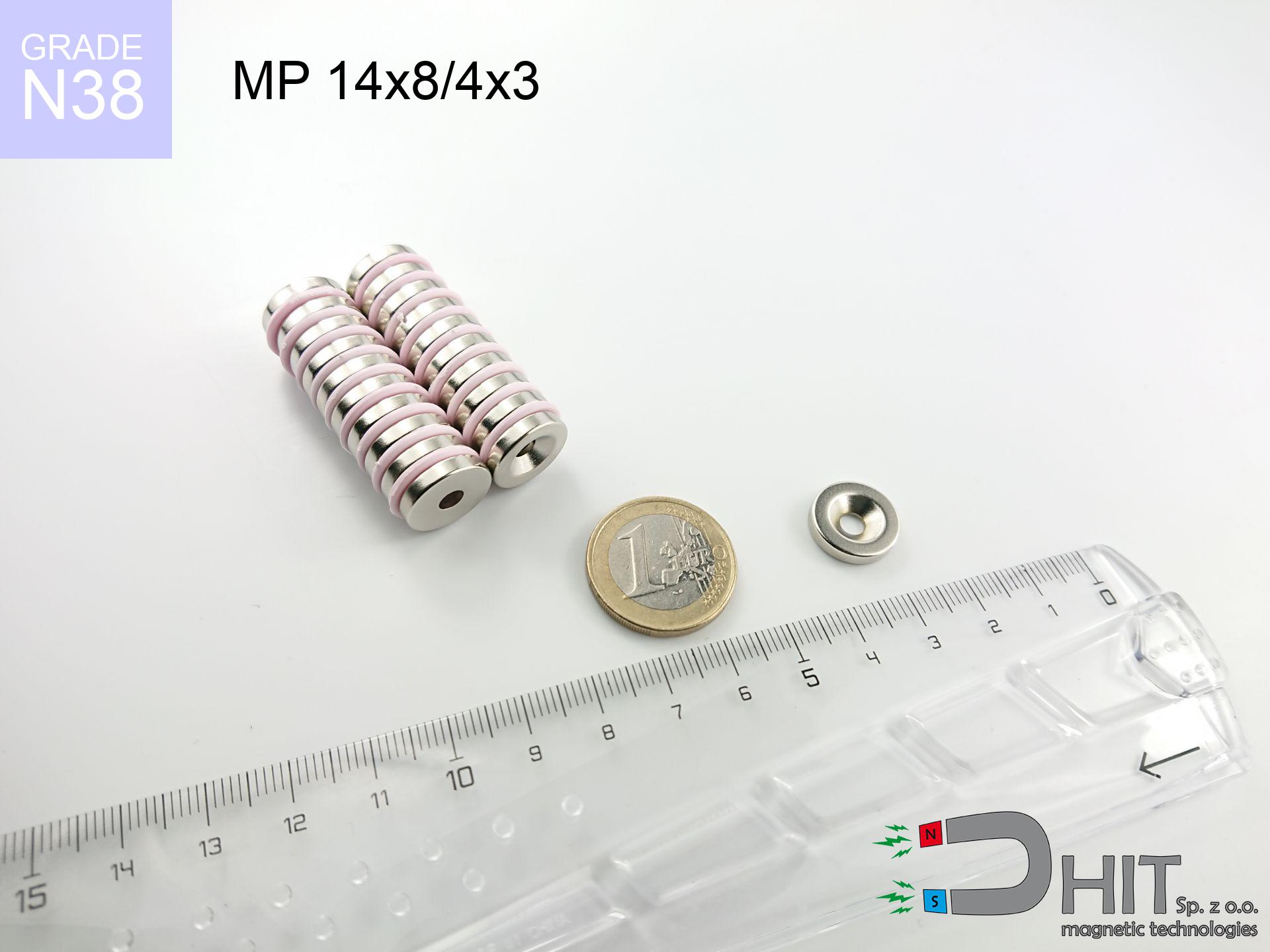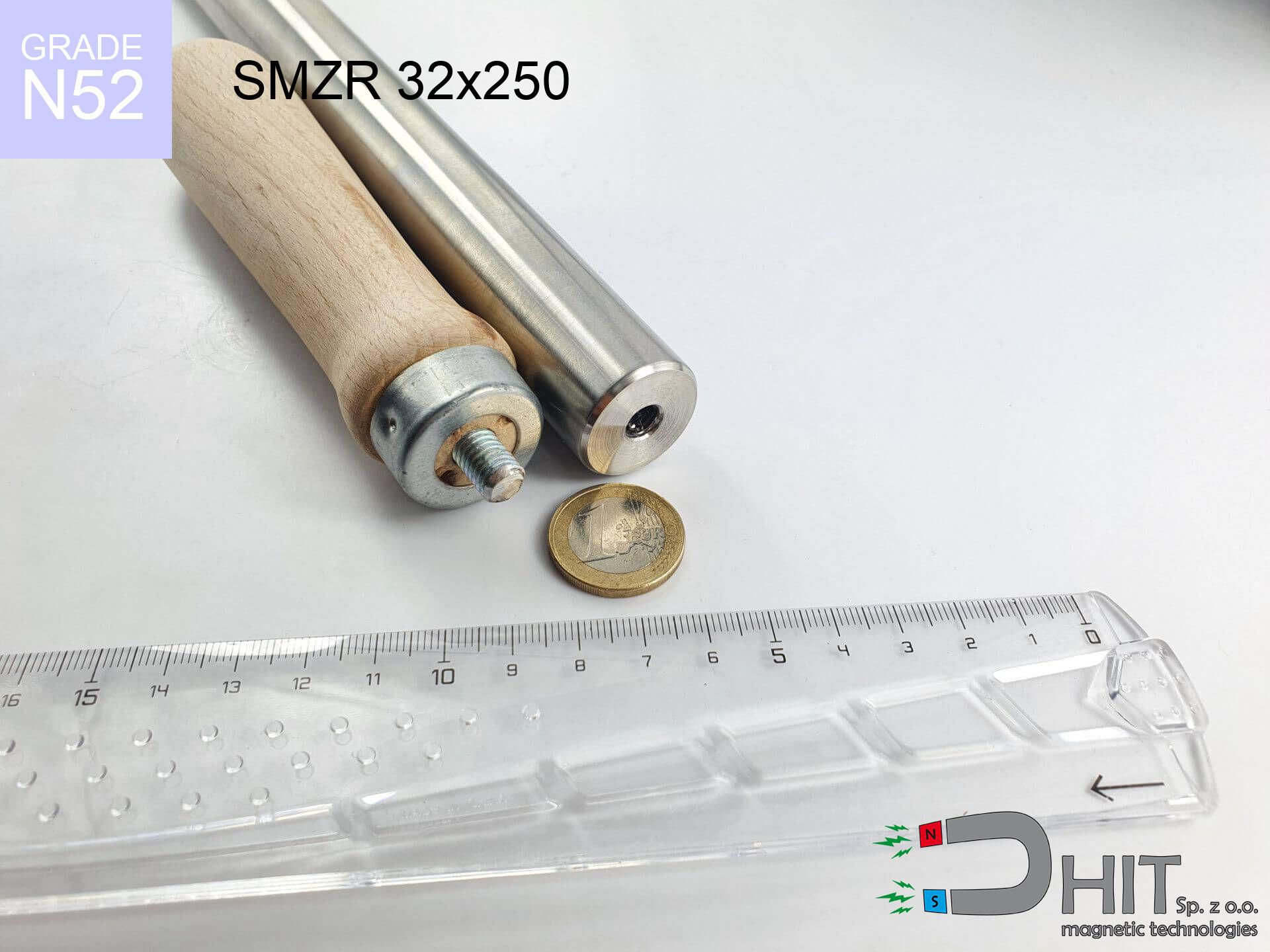UMP 135x40 [M10+M12] GW F600 Lina / N38 - search holder
search holder
Catalog no 210385
GTIN/EAN: 5906301814047
Diameter Ø
135 mm [±1 mm]
Height
40 mm [±1 mm]
Weight
4300 g
Load capacity
680.00 kg / 6668.52 N
Coating
[NiCuNi] Nickel
Magnetic Flux
~ 10 000 Gauss [±5%]
649.99 ZŁ with VAT / pcs + price for transport
528.45 ZŁ net + 23% VAT / pcs
bulk discounts:
Need more?
Call us
+48 22 499 98 98
or contact us through
request form
through our site.
Specifications and structure of magnetic components can be checked on our
force calculator.
Same-day shipping for orders placed before 14:00.
💡 Guide: How to choose a decent magnet and not get ripped off?
Don't be fooled by amateur online tests – go for certified quality and specific parameters that guarantee success:
- 📏 Magnet thickness in the casing (min. 10mm) – This is what matters most! Thin magnets are weak. Thanks to the 1cm thickness of N52 neodymium, your magnet "sees" metal even through thick rust and mud.
- 🛡️ Armored protection (Black Epoxy) – Forget about rust. This coating doesn't chip when hitting rocks and protects the magnet in water much better than regular nickel, which fails quickly.
- 🧲 Eyelets that don't steal power – Made of special non-magnetic steel, so they don't stick to the magnet and don't block the force. Important: mount only one eyelet at a time! Using 3 at once is a mistake that weakens the magnet.
- 🧶 Certified rope (min. 8mm) – You gain the certainty that your gear won't stay at the bottom. It's thick and comfortable, so it doesn't cut your fingers when pulling out heavy scrap metal.
- 🚀 Our advantage: We are the only ones combining the strongest N52 neodymium (10mm thick) with non-magnetic eyelets. This is real power and durability you won't find anywhere else.
Invest in solid equipment and enjoy the results!
Technical specification - UMP 135x40 [M10+M12] GW F600 Lina / N38 - search holder
Specification / characteristics - UMP 135x40 [M10+M12] GW F600 Lina / N38 - search holder
| properties | values |
|---|---|
| Cat. no. | 210385 |
| GTIN/EAN | 5906301814047 |
| Production/Distribution | Dhit sp. z o.o. |
| Country of origin | Poland / China / Germany |
| Customs code | 85059029 |
| Diameter Ø | 135 mm [±1 mm] |
| Height | 40 mm [±1 mm] |
| Weight | 4300 g |
| Load capacity ~ ? | 680.00 kg / 6668.52 N |
| Coating | [NiCuNi] Nickel |
| Holder Type | 2 sided |
| Material Type | Structural steel S235 (ferrous) |
| Magnetic Flux | ~ 10 000 Gauss [±5%] |
| Rope Length | 25 m |
| Rope Capacity | ~ 1595 kg |
| Rope Diameter | Ø 8 mm |
| Gloves | 1 pair |
| Size/Mount Quantity | 3xM10 |
| Manufacturing Tolerance | ±1 mm |
Magnetic properties of material N38
| properties | values | units |
|---|---|---|
| remenance Br [min. - max.] ? | 12.2-12.6 | kGs |
| remenance Br [min. - max.] ? | 1220-1260 | mT |
| coercivity bHc ? | 10.8-11.5 | kOe |
| coercivity bHc ? | 860-915 | kA/m |
| actual internal force iHc | ≥ 12 | kOe |
| actual internal force iHc | ≥ 955 | kA/m |
| energy density [min. - max.] ? | 36-38 | BH max MGOe |
| energy density [min. - max.] ? | 287-303 | BH max KJ/m |
| max. temperature ? | ≤ 80 | °C |
Physical properties of sintered neodymium magnets Nd2Fe14B at 20°C
| properties | values | units |
|---|---|---|
| Vickers hardness | ≥550 | Hv |
| Density | ≥7.4 | g/cm3 |
| Curie Temperature TC | 312 - 380 | °C |
| Curie Temperature TF | 593 - 716 | °F |
| Specific resistance | 150 | μΩ⋅cm |
| Bending strength | 250 | MPa |
| Compressive strength | 1000~1100 | MPa |
| Thermal expansion parallel (∥) to orientation (M) | (3-4) x 10-6 | °C-1 |
| Thermal expansion perpendicular (⊥) to orientation (M) | -(1-3) x 10-6 | °C-1 |
| Young's modulus | 1.7 x 104 | kg/mm² |
Material specification
| iron (Fe) | 64% – 68% |
| neodymium (Nd) | 29% – 32% |
| boron (B) | 1.1% – 1.2% |
| dysprosium (Dy) | 0.5% – 2.0% |
| coating (Ni-Cu-Ni) | < 0.05% |
Ecology and recycling (GPSR)
| recyclability (EoL) | 100% |
| recycled raw materials | ~10% (pre-cons) |
| carbon footprint | low / zredukowany |
| waste code (EWC) | 16 02 16 |
Check out also offers
Strengths as well as weaknesses of Nd2Fe14B magnets.
Strengths
- They have stable power, and over around ten years their attraction force decreases symbolically – ~1% (in testing),
- Magnets effectively resist against loss of magnetization caused by ambient magnetic noise,
- In other words, due to the shiny finish of gold, the element looks attractive,
- Magnetic induction on the working layer of the magnet is very high,
- Made from properly selected components, these magnets show impressive resistance to high heat, enabling them to function (depending on their form) at temperatures up to 230°C and above...
- Due to the potential of free molding and customization to specialized solutions, NdFeB magnets can be modeled in a variety of shapes and sizes, which increases their versatility,
- Versatile presence in modern technologies – they are used in magnetic memories, drive modules, advanced medical instruments, and other advanced devices.
- Compactness – despite small sizes they offer powerful magnetic field, making them ideal for precision applications
Weaknesses
- They are fragile upon too strong impacts. To avoid cracks, it is worth protecting magnets using a steel holder. Such protection not only protects the magnet but also increases its resistance to damage
- NdFeB magnets lose strength when exposed to high temperatures. After reaching 80°C, many of them experience permanent weakening of power (a factor is the shape and dimensions of the magnet). We offer magnets specially adapted to work at temperatures up to 230°C marked [AH], which are extremely resistant to heat
- When exposed to humidity, magnets usually rust. To use them in conditions outside, it is recommended to use protective magnets, such as those in rubber or plastics, which secure oxidation as well as corrosion.
- We recommend casing - magnetic mount, due to difficulties in realizing nuts inside the magnet and complex forms.
- Potential hazard to health – tiny shards of magnets are risky, if swallowed, which is particularly important in the context of child safety. Furthermore, small elements of these devices are able to be problematic in diagnostics medical when they are in the body.
- Due to neodymium price, their price exceeds standard values,
Holding force characteristics
Maximum lifting capacity of the magnet – what contributes to it?
- on a block made of structural steel, effectively closing the magnetic field
- possessing a thickness of minimum 10 mm to avoid saturation
- characterized by smoothness
- with total lack of distance (no paint)
- for force acting at a right angle (pull-off, not shear)
- at ambient temperature room level
Practical lifting capacity: influencing factors
- Gap between magnet and steel – even a fraction of a millimeter of distance (caused e.g. by veneer or dirt) drastically reduces the magnet efficiency, often by half at just 0.5 mm.
- Angle of force application – maximum parameter is available only during perpendicular pulling. The shear force of the magnet along the plate is typically many times smaller (approx. 1/5 of the lifting capacity).
- Plate thickness – too thin sheet causes magnetic saturation, causing part of the flux to be wasted into the air.
- Plate material – mild steel attracts best. Alloy steels decrease magnetic permeability and holding force.
- Plate texture – smooth surfaces guarantee perfect abutment, which improves force. Rough surfaces weaken the grip.
- Thermal conditions – neodymium magnets have a negative temperature coefficient. At higher temperatures they are weaker, and in frost gain strength (up to a certain limit).
Lifting capacity testing was carried out on a smooth plate of suitable thickness, under a perpendicular pulling force, however under shearing force the load capacity is reduced by as much as fivefold. In addition, even a small distance between the magnet’s surface and the plate lowers the holding force.
H&S for magnets
Nickel allergy
A percentage of the population experience a hypersensitivity to Ni, which is the common plating for neodymium magnets. Prolonged contact might lead to an allergic reaction. We suggest wear safety gloves.
Magnetic interference
Be aware: rare earth magnets produce a field that confuses precision electronics. Keep a separation from your mobile, tablet, and GPS.
Eye protection
Despite metallic appearance, the material is brittle and cannot withstand shocks. Avoid impacts, as the magnet may crumble into sharp, dangerous pieces.
Powerful field
Handle magnets with awareness. Their powerful strength can shock even experienced users. Be vigilant and respect their force.
Danger to the youngest
These products are not toys. Eating a few magnets may result in them pinching intestinal walls, which poses a critical condition and requires immediate surgery.
Crushing risk
Large magnets can break fingers in a fraction of a second. Do not place your hand between two strong magnets.
Dust is flammable
Powder generated during cutting of magnets is combustible. Avoid drilling into magnets without proper cooling and knowledge.
Permanent damage
Monitor thermal conditions. Heating the magnet to high heat will permanently weaken its magnetic structure and strength.
Protect data
Intense magnetic fields can corrupt files on credit cards, hard drives, and other magnetic media. Stay away of at least 10 cm.
Danger to pacemakers
People with a ICD should keep an absolute distance from magnets. The magnetic field can stop the operation of the life-saving device.

![Fishing magnet UMP 135x40 [M10+M12] GW F600 Lina / N38 - GOLD Series Fishing magnet UMP 135x40 [M10+M12] GW F600 Lina / N38 - GOLD Series](https://cdn3.dhit.pl/graphics/banners/magnet.webp)
![UMP 135x40 [M10+M12] GW F600 Lina / N38 - search holder](https://cdn3.dhit.pl/graphics/products/ump-135x40-m10+m12-gw-f600-+lina-sej.jpg)

![UMGW 32x18x8 [M6] GW / N38 - magnetic holder internal thread UMGW 32x18x8 [M6] GW / N38 - magnetic holder internal thread](https://cdn3.dhit.pl/graphics/products/um32x18x8-m6-gw--hec.jpg)
![SM 25x200 [2xM8] / N52 - magnetic separator SM 25x200 [2xM8] / N52 - magnetic separator](https://cdn3.dhit.pl/graphics/products/sm-25x200-2xm8-jas.jpg)


